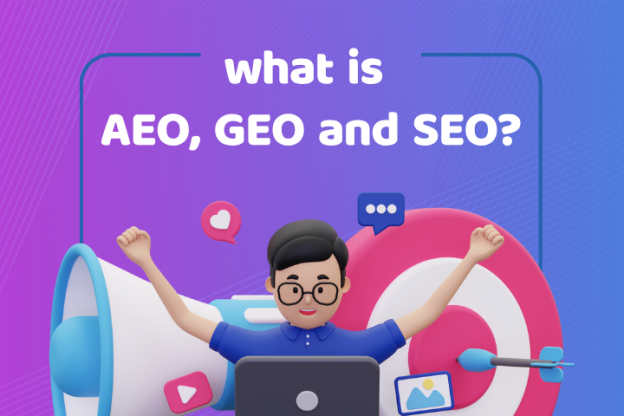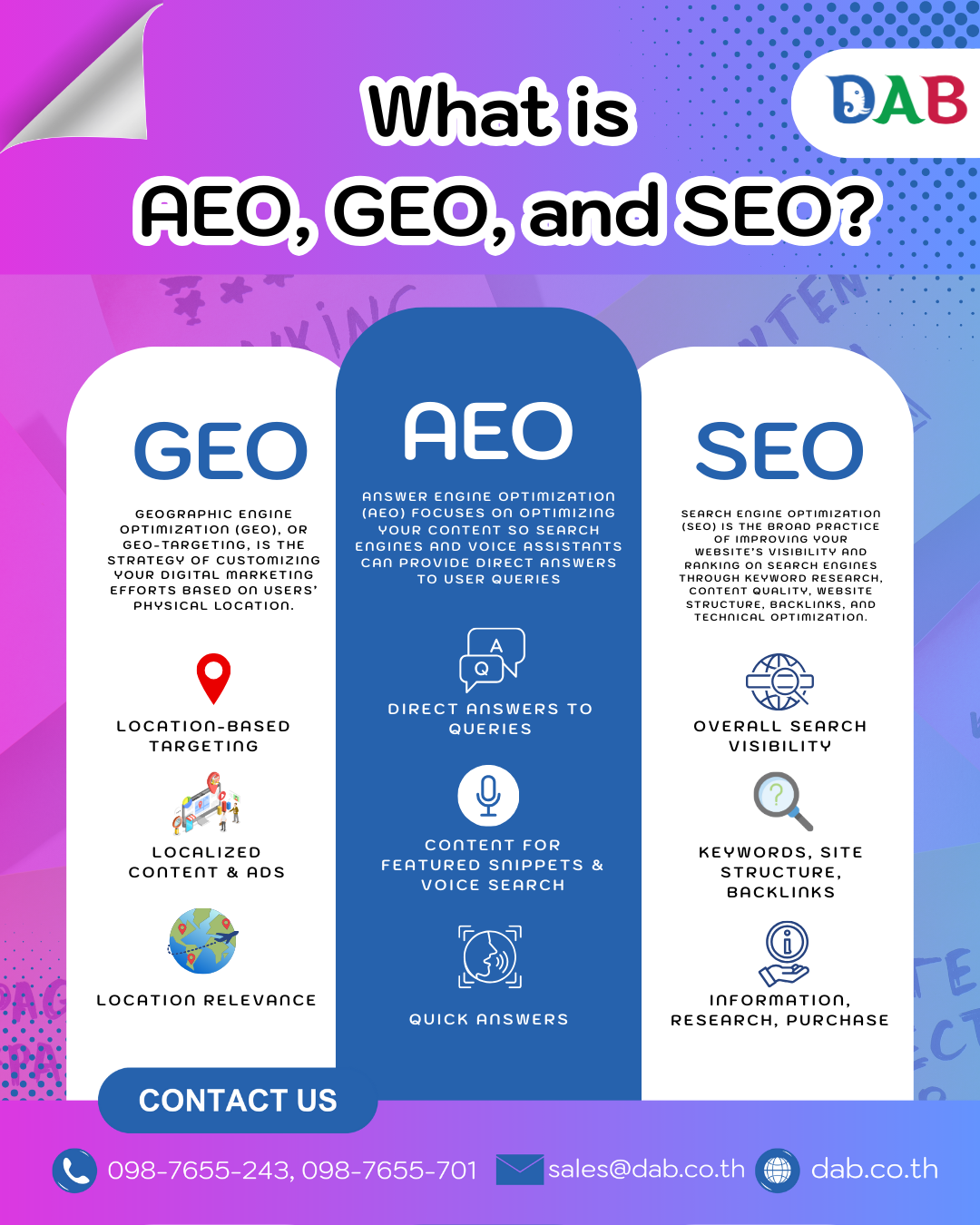What are the differences between AEO, GEO, and SEO?

Introduction
In digital marketing, acronyms like AEO, GEO, and SEO are often used interchangeably but they have distinct meanings and roles. Knowing these differences can help your business develop smarter strategies that target the right audience effectively. Here’s a deeper look into what AEO, GEO, and SEO mean, how they differ, and why they’re essential.
What is AEO?
Answer Engine Optimization (AEO) focuses on optimizing your content so search engines and voice assistants can provide direct answers to user queries. Unlike traditional SEO that targets keyword rankings, AEO aims to get your content featured as immediate answers or “position zero” on Google or in voice search results.
Why is AEO important?
With the rise of voice assistants like Siri, Alexa, and Google Assistant, users expect quick, concise answers without needing to click further. Businesses that adopt AEO can capture this growing voice search traffic, improving engagement and trust by providing immediate solutions.
What is GEO?
GEO stands for Generative Engine Optimization. It is the process of optimizing your content to be recognized, cited, or used by AI-powered search engines like ChatGPT, Google SGE, Bing Copilot, and Perplexity.
Unlike traditional SEO, which focuses on rankings in search engine results pages (SERPs), GEO ensures your brand appears directly within AI-generated answers — where users are increasingly getting information without visiting a website.
Why is GEO important?
AI assistants are changing how people search. GEO helps your content get selected by AI tools as a reliable source — increasing brand visibility, authority, and traffic in the age of zero-click search.
What is SEO?
Search Engine Optimization (SEO) is the broad practice of improving your website’s visibility and ranking on search engines through keyword research, content quality, website structure, backlinks, and technical optimization.
Why is SEO important?
SEO drives organic traffic, helping your website appear in search results when users look for related products or services. It builds long-term authority and visibility, forming the backbone of your online presence.
Key Differences Between AEO, GEO, and SEO
| Aspect | AEO (Answer Engine Optimization) | GEO (Generative Engine Optimization) | SEO (Search Engine Optimization) |
|---|---|---|---|
| Focus | Direct answers to questions | Optimizing for AI-generated search and summaries | Ranking on traditional search engine results |
| Optimization Type | Structured content, FAQ, featured snippets, schema | Semantic clarity, source attribution, AI-readable formats | Keywords, site structure, backlinks |
| Primary Use Case | Voice search, smart assistants, featured snippets | ChatGPT, Google SGE, Perplexity, Bing Copilot, AI search tools | Google, Bing, and other search engines |
| User Intent | Quick, concise answers | In-depth reliable content AI can cite | Information, research, product or service discovery |
| Benefit | Immediate visibility in voice search & snippets | Visibility inside AI-generated answers with zero-click exposure | Long-term growth in organic website traffic |
How These Strategies Complement Each Other
Using SEO, AEO, and GEO together creates a future-ready search strategy:
- SEO builds your website’s visibility on traditional search engines like Google by improving keyword rankings, backlinks, and site structure.
- AEO ensures your content is optimized for direct answers — ideal for voice assistants, featured snippets, and zero-click search.
- GEO focuses on optimizing content for generative AI search platforms like ChatGPT, Google SGE, and Perplexity, helping your brand appear in AI-generated responses.
Combined, these strategies maximize your presence across search formats — traditional, conversational, and AI-generated — increasing the likelihood that your brand is found by the right people, in the right context, at the right moment.
Why Your Business Needs All Three
As search behavior evolves toward voice, AI, and real-time answers, relying on traditional SEO alone is no longer sufficient. By integrating AEO and GEO, you can:
-
Capture visibility in AI-generated answers and emerging search interfaces.
-
Serve user intent more effectively across formats: text, voice, and chat.
-
Future-proof your digital presence in a search landscape shaped by artificial intelligence.

Conclusion
Understanding the differences and purposes of AEO, GEO, and SEO helps you craft a more effective digital marketing plan. While SEO remains fundamental, embracing GEO and AEO strategies prepares your business for the future of search, where immediacy and localization are key. Adopting all three ensures your brand connects meaningfully with customers in diverse ways, driving growth and engagement.
Need expert advice or a free consultation on digital marketing strategies? Contact Digital Agency Bangkok.
Call: 098-7655-243 / 098-7655-701
Website: digitalagencybangkok.com
Email [email protected]
FAQ – Frequently Asked Questions
Q1: What is AEO?
A1: AEO, or Answer Engine Optimization, is the strategy of optimizing your website content so that AI can use it to answer user questions directly, such as ChatGPT, Google SGE, or Bing Copilot. Unlike traditional SEO, AEO focuses on making your content the answer that AI chooses to display immediately.
Q2: What is GEO?
A2: GEO, or Generative Engine Optimization, is about optimizing your content so that AI can generate answers based on your content. For example, Google AI Overview may use your article to summarize or explain information directly to users without them needing to click into your website.
Q3: What is SEO?
A3: SEO, or Search Engine Optimization, is the process of optimizing your website to rank higher on Google and other search engines through keywords, website structure, quality content, and backlinks. It helps drive traffic to your site without paid ads.
Q4: How are AEO, GEO, and SEO different?
A4:
- AEO focuses on letting AI use your website content to answer questions directly.
- GEO focuses on optimizing content so AI can generate answers from your content.
- SEO focuses on ranking your website higher and driving traffic through traditional search results.
Q5: Why should businesses use all three strategies together?
A5: Combining SEO, AEO, and GEO allows your business to reach users across multiple channels, including Google, AI, and other platforms. Your content can be selected as direct answers, build credibility, and expand your reach to your target audience more effectively.
Q6: Do I need a website for AEO/GEO?
A6: Yes. A website allows AI to access and use your content as a source. Without a website, your business information may not appear in AI-generated answers.
Q7: How can I tell if my content is being used by AI?
A7: You can check by testing searches on ChatGPT, Google SGE, or Bing Copilot. If AI summarizes your information or references your content, it means your content is being selected.
Q8: Should I do it myself or hire a professional?
A8: You can optimize content yourself if you understand the principles. However, hiring a digital agency or expert can save time and increase the chances that your content will perform well in both AI and SEO results.



